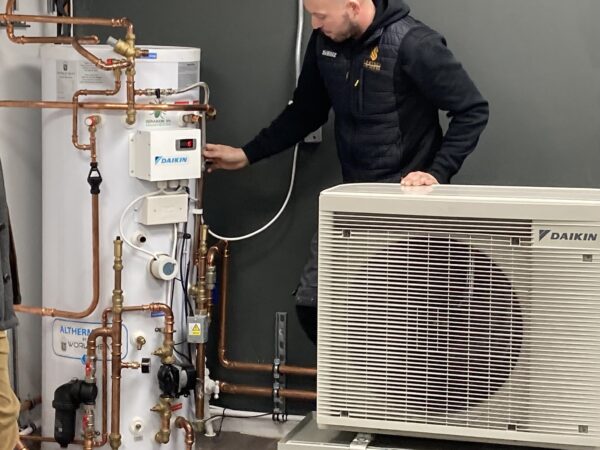What is retrofit?
People in the construction industry talk about retrofit a lot and in the coming years, especially with the government planning on increasing minimum EPC ratings for private lets to an EPC rating of C, the term ‘retrofit’ is likely to get even more mainstream attention. The national target to hit Net Zero by 2030, the UK’s housing stock being amongst the oldest in Europe and rising energy bills are all factors that play into retrofit’s rising popularity.
Despite that, a lot of people still aren’t sure what ‘retrofit’ actually means. In fact, 60% of homeowners don’t know what ‘retrofit’ means, according to Cosy Homes Oxfordshire, leaving a lot of people asking: what is retrofit?
Table of Contents
What is Domestic Retrofit?
Home retrofit, also referred to as domestic retrofit, is largely about adding energy-saving measures to an already-built home. These measures can include putting solar panels on a roof, adding internal or external insulation (also referred to broadly as IWI and EWI respectively), draught excluders, or swapping out single-glazed windows for double-glazed and more.
Domestic retrofit isn’t just about energy-saving measures; customers may be motivated by care for the environment, improved comfort or health concerns. Domestic retrofit measures can address these issues in various ways; generating electricity from solar panels to power a heat pump can save money while reducing dependency on fossil fuels, while insulating a home with bio-based materials such as wood fibre insulation or lime plaster can improve indoor air quality (IAQ). Adequate ventilation is important for moisture management and good air quality in homes.
Domestic retrofit doesn’t always mean a huge investment of money and time. While an extensive whole-house retrofit could mean installing an air source heat pump, an MVHR ventilation unit, sustainable carbon-negative internal wall insulation (like from Unity Lime), lighter-touch retrofit could include economical interventions such as adding trickle vents to a window to improve ventilation in the home or blocking unused fireplaces to prevent heat loss.. Retrofit could mean a homeowner hiring a team of professionals including a retrofit coordinator and a retrofit assessor, or it could be part of a DIY project.

The beauty of retrofit is that it can fit your own requirements and specifications, and it can often be carried out part-by-part over time.
What is Commercial Retrofit?
Commercial retrofit includes much of the same measures as domestic retrofit, such as installing heat pumps, solar panels, and ventilation. It differs in project size and cost but, again, it can be performed with a large degree of modularity. Larger scale retrofit schemes such as ECO4 will vary in measures but will follow the PAS2035 retrofit quality framework and include a retrofit coordinator, a retrofit assessor, and other qualified professionals.
Other terms for Retrofit
There isn’t just any one term for ‘retrofit.’ Some people refer to it as smart renovation, energy-saving refurbishment or home improvement These are all terms that carry the same meaning – improving the performance of a home by- adding something t that wasn’t there previously, typically for energy-saving, environmental reasons and for the comfort of occupants.
Is retrofit suitable for every homeowner?
Many homes in the UK are older and most can benefit from retrofit measures to reduce heat loss and running costs, while improving comfort. But many homeowners don’t know how to start a retrofit project or how to find a trustworthy, qualified contractor. That’s why The Green Register has launched the Retrofit Skills course, a Level 2 qualification accredited by ABBE, that is suitable for contractors, trades, architects, self-builders and others who want to understand the principles and practices of domestic retrofit.
It’s also why our partner company, Retrofit West, offers a trade directory of companies in the West of England region that are vetted and trusted to carry out retrofit works.
Why learn more about Retrofit?
If you’d like to learn about the foundations of a successful retrofit, whether you’re a homeowner, architect, builder, plasterer, or any other type of contractor, and whether or not you’re still wondering to yourself, ‘what is retrofit?’, you should register onto our Retrofit Skills Level 2 course. You’ll open yourself up to more opportunities from increased homeowner demand for retrofit, allowing for better business growth and personal satisfaction by making a huge impact.
Retrofit Skills Level 2 is a hybrid qualification, with both online and practical components, which provides foundational training for individuals and businesses looking to move into retrofit construction.
It’s suitable for contractors, architects, tradespeople and other professionals who wish to develop or improve their technical knowledge in achieving high quality outcomes in low carbon retrofit in the domestic sector, and is also suitable for homeowners undergoing their own retrofit who would like to know more about how to retrofit a home successfully while avoiding common pitfalls.
You’ll never have to ask ‘what is retrofit’ again.

